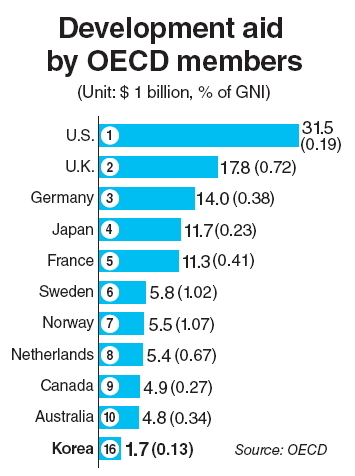Korea doled out more than $1.74 billion in official development assistance in 2013, up about 9.2 percent from a year before, as the world’s 16th largest donor country, the Prime Minister’s Secretariat said Wednesday.
Seoul spent $1.3 billion in bilateral aid, consisting of $800 million in grants and $500 million in low-interest loans, and $450 million in multilateral projects run by international organizations.

Despite the increase, the sum represents a paltry 0.13 percent of gross national income, far lower than the 0.3 percent average of the 28 member countries of the Organization for Economic Cooperation and Development’s Development Assistance Committee, a club of the world’s major patrons of poor countries.
“We maintained our policy of expanding ODA, whereas a sizeable number of countries were scaling down amid the global economic downturn and their resulting financial difficulties,” the secretariat said in a statement.
“We will make consistent efforts to increase our assistance and its effect.”
By region, nearly 56 percent of bilateral support went to Asia, followed by Africa with 21.3 percent, Latin America with 7.4 percent and the Middle East with 3.1 percent.
The disbursements chiefly funded transportation, logistics and other infrastructure construction, as well as education and health programs in developing countries.
The Paris-based group said its collective aid hit a record high of $134.8 billion last year, though Europe’s commitments remained sluggish in the face of economic doldrums.
Of the 28 members, 17 raised contributions, while 11 trimmed down.
The U.S. was the biggest ODA provider, giving more than $31.5 billion alone last year. The U.K. came second with $17.9 billion, followed by Germany with $14.1 billion, Japan with $11.8 billion and France with $11.4 billion.
Seoul joined the DAC in 2010, marking its ascent from a major aid recipient to the world’s 16th biggest donor in a few decades.
But specialists and relief workers have been calling for greater commitment, a larger skilled workforce and long-term strategies focusing on grants rather than loans, while expressing concern over persistent tension between the responsible state agencies and their conflicting plans.
The government recently revised down its 2015 target of hiking the ODA-to-GNI ratio to 0.25 percent to 0.2 percent, blaming snowballing welfare outlays and shriveling tax revenues.
By Shin Hyon-hee (heeshin@heraldcorp.com)
Seoul spent $1.3 billion in bilateral aid, consisting of $800 million in grants and $500 million in low-interest loans, and $450 million in multilateral projects run by international organizations.

Despite the increase, the sum represents a paltry 0.13 percent of gross national income, far lower than the 0.3 percent average of the 28 member countries of the Organization for Economic Cooperation and Development’s Development Assistance Committee, a club of the world’s major patrons of poor countries.
“We maintained our policy of expanding ODA, whereas a sizeable number of countries were scaling down amid the global economic downturn and their resulting financial difficulties,” the secretariat said in a statement.
“We will make consistent efforts to increase our assistance and its effect.”
By region, nearly 56 percent of bilateral support went to Asia, followed by Africa with 21.3 percent, Latin America with 7.4 percent and the Middle East with 3.1 percent.
The disbursements chiefly funded transportation, logistics and other infrastructure construction, as well as education and health programs in developing countries.
The Paris-based group said its collective aid hit a record high of $134.8 billion last year, though Europe’s commitments remained sluggish in the face of economic doldrums.
Of the 28 members, 17 raised contributions, while 11 trimmed down.
The U.S. was the biggest ODA provider, giving more than $31.5 billion alone last year. The U.K. came second with $17.9 billion, followed by Germany with $14.1 billion, Japan with $11.8 billion and France with $11.4 billion.
Seoul joined the DAC in 2010, marking its ascent from a major aid recipient to the world’s 16th biggest donor in a few decades.
But specialists and relief workers have been calling for greater commitment, a larger skilled workforce and long-term strategies focusing on grants rather than loans, while expressing concern over persistent tension between the responsible state agencies and their conflicting plans.
The government recently revised down its 2015 target of hiking the ODA-to-GNI ratio to 0.25 percent to 0.2 percent, blaming snowballing welfare outlays and shriveling tax revenues.
By Shin Hyon-hee (heeshin@heraldcorp.com)



![[AtoZ into Korean mind] Humor in Korea: Navigating the line between what's funny and not](http://res.heraldm.com/phpwas/restmb_idxmake.php?idx=644&simg=/content/image/2024/04/22/20240422050642_0.jpg&u=)

![[Exclusive] Korean military set to ban iPhones over 'security' concerns](http://res.heraldm.com/phpwas/restmb_idxmake.php?idx=644&simg=/content/image/2024/04/23/20240423050599_0.jpg&u=20240423183955)

![[Herald Interview] Why Toss invited hackers to penetrate its system](http://res.heraldm.com/phpwas/restmb_idxmake.php?idx=644&simg=/content/image/2024/04/22/20240422050569_0.jpg&u=20240422150649)
![[Graphic News] 77% of young Koreans still financially dependent](http://res.heraldm.com/phpwas/restmb_idxmake.php?idx=644&simg=/content/image/2024/04/22/20240422050762_0.gif&u=)






![[Exclusive] Korean military to ban iPhones over security issues](http://res.heraldm.com/phpwas/restmb_idxmake.php?idx=652&simg=/content/image/2024/04/23/20240423050599_0.jpg&u=20240423183955)



![[Today’s K-pop] Ateez confirms US tour details](http://res.heraldm.com/phpwas/restmb_idxmake.php?idx=642&simg=/content/image/2024/04/23/20240423050700_0.jpg&u=)